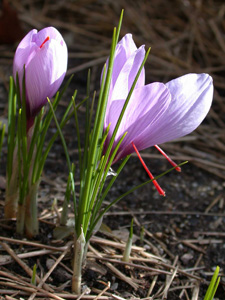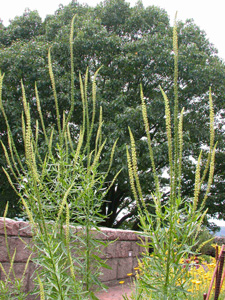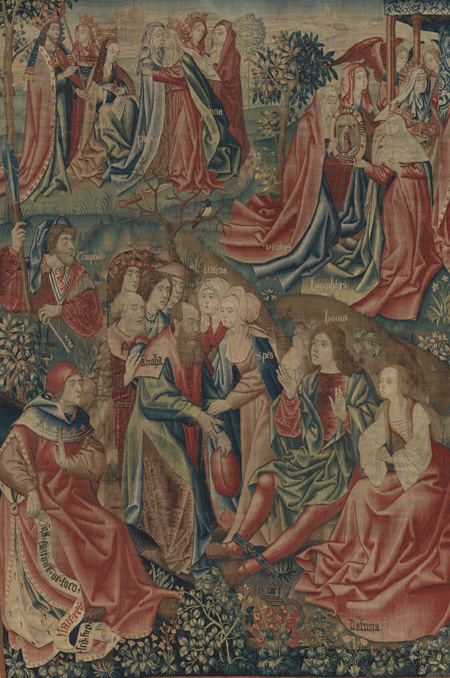
The magpie in the leafless tree that spreads above the patriarchs and the bramble growing at the shackled feet of Man appear in a single scene from the magnificent allegorical tapestry Christ is Born as Man’s Redeemer (Episode from The Story of the Redemption of Man) on display at The Cloisters. Both the bird and the bush may be interpreted as symbolic expressions of Man’s fallen condition, which can yet be redeemed???the overarching theme of the series of ten hangings to which this work belongs.
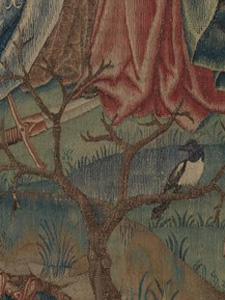
Although the testimony of medieval bestiaries, sermons, allegories, and other sources encourage us to assign symbolic values to birds, plants, and animals, they are not always meant to bear a special meaning, and a very considerable range of meanings might be assigned to the same beast or plant. Sometimes exaggerated size or prominent placement is a clue that we are meant to pay special attention, but the possible significance of a natural symbol depends very much on the context of the individual work of art. I’d like to look at the magpie and the bramble shown above in the thematic context of human frailty, reconciliation, and redemption found in this tapestry.
The black-billed magpie (Pica pica) is a Eurasian species common in Europe and Britain. Before the seventeenth century, the bird was known simply as a “pie” or “pye,” from pie, the Old French rendering of the Latin pica, the feminine form of the name for woodpecker (see etymology), although magpies are corvids and are more closely related to crows, jackdaws, and jays than to woodpeckers. The English adjective “pied” or “piebald,” applied to particolored animals, is derived from the striking black-and-white plumage of the magpie. (The name for a baked dish with a pastry crust may ultimately have the same avian origin; see a related post on the blog The Salt).
Ancient and medieval natural historians were struck by the similarity of the magpie’s chatter to human speech (see, for example, The Natural History of Pliny), and the bird enjoyed a reputation for intelligence???an estimation borne out by modern research???but the character of the medieval magpie was as mixed as its plumage. The bird’s cleverness and its thieving habits were not altogether admirable; by the fifteenth century, a sly or wily person was called a “pye.” William Harrison, in the 1587 edition of his Description of England, tells a story of a chaplain, himself “the wiliest pye of all,” who persuades his patroness that the noisy magpies that pester her are not birds but souls in purgatory, clamoring for release. In a separate discussion of the birds of England, Harrison classes the magpie as an “unclean” bird, along with ravens and crows. According to the Continuum Encyclopedia of Animals in Art the magpie is associated with death in Western art, and appears as a “gallows bird” in the work of Northern painters like Pieter Bruegel the Elder (e.g., The Magpie on the Gallows) and Hieronymus Bosch. The magpie in Bosch’s Prodigal Son has been interpreted as an emblem of the prodigal’s soul, representing the phases of his conversion. The dual nature of the magpie, manifest in its black-and-white coloration, was also associated with frailty and inconstancy.

Magpies are frequently depicted in medieval art. In this detail from the left-hand panel of the Annunciation Triptych (Merode Altarpiece), a magpie perches high on the stepped gable above the entry to the courtyard of the Virgin’s house. (For a gallery of magpie images from medieval manuscripts, visit the Medieval Bestiary.)
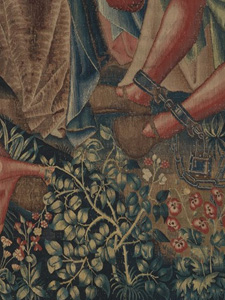
I take the thorny bush at the feet of Man, which might look like a small-flowered wild rose at first blush, to be another member of the rose family, the common bramble or blackberry, Rubus fruticosus, with immature fruit. The unripe red “berry” of the bramble, actually a cluster of little drupelets, turns black as the fruit matures. (The ARKIVE website features a gallery of images of the common bramble in all its stages of growth, and a time-lapse video of the formidable speed with which it grows.) According to Genesis 3:17???18, thorns and thistles first came into the world when the ground was cursed after the fall of Adam and Eve. Thorny plants are often associated with error, sin, and the fallen state of humankind in medieval art. The black-fruited bramble was also associated with death. For another example of a thorny plant in an allegorical context of human frailty, also in The Cloisters collection, see Old Age Drives the Stag out of a Lake and the Hounds Heat, Grief, Cold, Anxiety, Age, and Heaviness Pursue Him, in which the stag representing Mankind leaps toward a large rosebush armed with formidable thorns.
For more information on the identification of plants in medieval tapestry, see
“Name That Plant” (January 28, 2011) and “Name That Plant, Continued” (February 5, 2011).
For further investigations into natural symbols in medieval tapestry, please join me at The Cloisters this Sunday, February 3, for “Birds, Beasts, and Flowers.” We’ll meet in the Main Hall at noon and spend an hour in the galleries. The program will repeat at 2:00 p.m. For more on gallery talks, programs, and events at the Museum, see Events at the Cloisters.
???Deirdre Larkin

